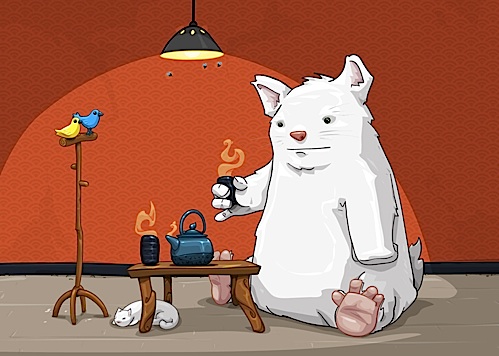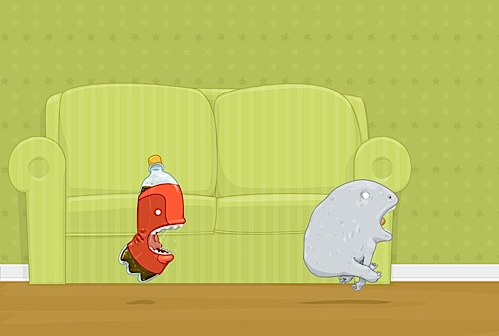
David Lanham zählt schon seit langem zu meinen absoluten Lieblingsillustratoren, daher freue ich mich natürlich ganz besonders, heute ein Interview mit ihm zu präsentieren. Wer einen Mac sein Eigen nennt und hin und wieder Icons von The Iconfactory herunterlädt, hat mit ziemlicher Sicherheit schon mal die verspielten, aber gleichzeitig sehr klaren und wiedererkennbaren Arbeiten Lanhams gesehen. Kleiner Tip: die meisten Illustration können auf seiner Website als hochauflösende Desktop-Wallpaper heruntergeladen werden…
The Past
Diskursdisko: Hi David. To start things off, what’s your background? When did you start doing illustrations?
David Lanham: I’ve been doodling and drawing since I could hold a pencil and it’s just slowly evolved as I’ve learned how to do things better, refined techniques and taken drawing classes in college. My digital illustration began right before I entered college and started to experiment with Illustrator and Photoshop
The Art
Diskursdisko: How do you mainly produce your art? Do you have a system or method that you adhere to?
David Lanham: I just focus on what I find to be fun, I always like to try out new approaches. In the last few years I’ve definitely been heavy on final drawings being in vectors or other digital formats, but I’ve been moving back towards physical media since the end product is so much more satisfying when you can hold it in your hands. But whether the end is digital or not, I nearly always start out with pen and paper to sketch ideas.
Diskursdisko: What inspires you?
David Lanham: I’ve had inspiration come from just about anything. Music or other creative works are always a big source, but subtle things like seeing something out of the corner of my eye walking down the street or how light hits an object just right are great sources too.
Diskursdisko: Your artwork is often based around monsters, ghosts and strange creatures – where do you get these ideas?
David Lanham: Mostly from doodling circles and shapes in my sketchbook and I use my imagination to see things in the lines. Watching clouds or patterns in ceiling textures produces endless imagery as well. But mostly I just focus on what I think would be fun to draw and make creatures to entertain myself.
Diskursdisko: You also do icon design for the Iconfactory – how did you get into designing icons? Can you tell us a bit about the work process: How do you focus on what the essential parts of an image are, so that they fit to icon size without losing effect?
David Lanham: Designing icons was just a side hobby until I entered the Pixelpalooza contest held by the Iconfactory. They were very interested in my work and one day asked me up for an interview. Icons aren’t too different from other illustration, you have the same sketching, concept and planning stages like anything else. The end product is just optimized for screen resolutions which can mean it needs to be rendered in various sizes instead of just a single final piece of art. The main challenge is to communicate as much as you can in as simple a form as possible so that the icon retains clarity even at very tiny sizes.
Diskursdisko: When working for clients like magazines or companies, how do you keep up the balance between clients‘ wishes and concepts and your own need to produce art? Do you feel there actually is any difference between „commercial“ artwork and other art?
David Lanham: If the client comes to you because they like your approach or style then you have some leverage with presenting your own ideas into the work. So you just have to keep a balance there so both you and the client are satisfied with the end product. Commercial artwork is definitely different though, maybe not in the appearance of the end result, but how the artist approaches it. You only have to satisfy yourself with personal work, and client work always needs to satisfy someone else’s needs. There are definitely grey areas and not all of client work is 100% for them (otherwise they wouldn’t ask you to retain your personal style or feelings) but there is still a percentage that you have to make for someone else.

The Web
Diskursdisko: You’ve obviously got the website at dlanham.com , any other presences on the web you’d like to publicize? Social networking?
David Lanham: I’m on twitter as well as flickr.
Diskursdisko: As you use the internet to showcase your art, are there any other websites you feel have influenced you, opened your mind or shown you new ways of creating art?
David Lanham: I always get some great insights and inspiration from sites like Art Renewal Center and Drawn!
Diskursdisko: Of all the work you’ve created, or at least the ones showcased on your website, can you name a couple that you have a special love for or connection to?
David Lanham: My favorite drawing is still Tea for Three, I’m not exactly sure why, but it’s always just made me smile to look at. There’s nearly always something miniscule about each drawing that I fall in love with, usually it’s the parts I haven’t planned and just happen on accident.
The Future
Diskursdisko: Do you have any specific plans for the future direction of your artwork?
David Lanham: I just go where the drawings take me, lately it’s been more towards working with physical media such as gouache or colored pencil or even brush pens. I just experiment and have fun with it though and see what happens.
Diskursdisko: David, many thanks for the interview – is there anything you’d like to add?
David Lanham: Just a big thanks to you too! It was fun and very engaging questions. I definitely appreciate the interest in my artworks!
Weitere tolle Interviews mit Künstlern und Designern gibt es bei Diskursdisko.






